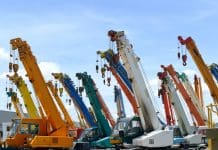Mammoet has begun the construction of a new 6,000-tonne electrical ring crane at their nerve centre in the Netherlands, making it the largest ring crane ever built
The fabrication and production of the ring crane are underway, and the project is scheduled to be delivered in 2024. The crane will be fully operational by electric power, allowing clients to improve the sustainability of their projects.
The 6,000-tonne ring crane will set a new standard in worldwide heavy lifting capacity and will enable users to construct heavier and larger components than ever before.
The ring crane will build on existing technology
The ring crane will be named SK6000 and shares the same engineering DNA as its predecessor, the SK350. Mammoet is using similar design principles and lifting used in their previous models. Much of the new crane’s technology has already worked successfully and safely on project sites worldwide.
The crane has been designed to work on next-generation offshore wind farms, allowing the model to serve global energy markets where additional lifting capacity is required – both onshore and at sea. The crane has been designed especially for turbine assembly and port handling work. Mammoet has previously been employed by Equinor to help construct the world’s largest floating offshore wind farm.
As offshore wind components are constantly growing in size and weight, more lift capacity is required. The new design will allow users to integrate bigger turbines and launch heavier fixed and floated foundations. The SK6000 will be containerised in the same way as previous models, allowing for quick mobilisation and on-site assembly.
The SK6000 could help improve the efficiency of offshore construction
It is hoped that the SK6000 will reduce the integration time of offshore and floating production projects in the conventional energy sector by building even larger topside modules. The crane could help refineries to reduce downtime on land by removing and installing large components with minimal disruption.
“Having worked on numerous large-scale offshore wind projects, we understand how important the logistics between port delivery and installation are to maintaining a schedule,” said Martin Tieman, project manager for Mammoet.
The SK6000 will be a fixed jib crane, meaning the crane will have a horizontal member. This allows the operating arm to extend horizontally from the crane.
“We don’t look at the SK as ‘just’ a crane, but we look at it as a system; it has evolved considerably since it was first launched. The SK6000 fixed jib is just the latest evolution in a crane series that allows small adjustments to have a large effect on performance, avoiding the need to research, develop and fabricate an entirely new crane,” said Mammoet technical expert Jeremy Haylock.

















